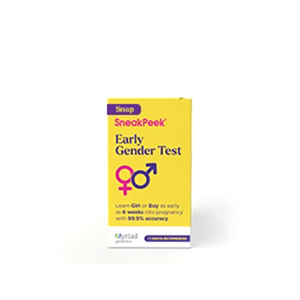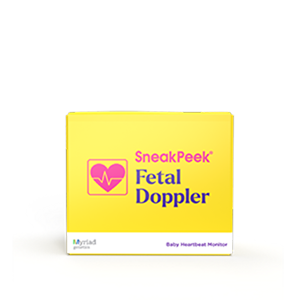Published on April 6th, 2023 and Updated on January 15th, 2024
Check out SneakPeek Gender Test to find out your baby’s gender as early as 6 weeks at over 99% accuracy1!
While you’re jumping up and down feeling every emotion under the sun (wait—can you jump up and down?! Hint: you can), we want to start by saying: congratulations, mama. You’re pregnant!
As you simmer in excitement, your brain might be swimming with a hundred different questions. How do I pick a prenatal vitamin? Should I tell my health insurance provider? Buy a pregnancy announcement t-shirt? With so much to do, where do you start?
Like they say, baby steps. There are nine months to prepare for your little one’s arrival, and not everything has to be done at once. Sit back and put your feet up while we discuss a mix of fundamental and fun items to add to your first-trimester prenatal checklist.
#1 Call Your OBGYN
Giving your OBGYN and health care provider a call to schedule your first early pregnancy, prenatal checkup is definitely at the top of the pregnancy to-do list. We recommend scheduling your first prenatal appointment as soon as you find out you’re pregnant, as some doctors’ offices are booked weeks in advance.
The first visit is usually completed between weeks 6 to 8 of your pregnancy, though some providers may recommend one later. Typically, it’s action-packed with procedures like:
- Confirming the pregnancy – At the start of your appointment, you’ll give a urine sample to clinically confirm your positive pregnancy test results. While it may feel strange at first, peeing in a cup will become second nature soon, as you’ll be giving a sample at each recurring checkup. The lab will test your urine for sugar, protein, ketones, and bacteria to ensure you don’t have a UTI and are at low risk for gestational diabetes and preeclampsia.
- Completing a checkup – Next, your doctor will conduct a general health exam. They’ll check your lungs, heart, and blood pressure. You’ll also receive a routine pelvic exam to ensure the health of your reproductive system.
- Labs and bloodwork – Your first prenatal checkup is the longest visit because of the tests performed to make sure you and your baby are in tip-top condition. In addition to that urine analysis, here are some other tests you can expect during your first visit:
- Bloodwork – You’ll have blood drawn for a prenatal panel, which determines important information like your blood count and blood type (these help detect health problems or infections in your first trimester). It also includes a hepatitis panel to make sure you don’t have hepatitis A, B, or C, as well as a cystic fibrosis screening to test whether you’re a carrier for the condition.
- STD tests – Your blood work test also tests for STDs, like syphilis, HIV, and more.
- Pap smear – During your pelvic exam, your doctor will perform a pap smear to check for the presence of any abnormal cervical cells.
- A blood sugar test – There are important steps to take with diabetes and pregnancy. If you had gestational diabetes during previous pregnancies, your doctor will ask you to take a blood test to see if your blood sugar levels are within normal range.
- Seeing your baby on an ultrasound – The moment you see that little bean (your future baby!) on an ultrasound is easily the most anticipated part of the first visit. Most women receive a transvaginal ultrasound during their first visit to confirm a healthy heartbeat at 7 to 8 weeks. The ultrasound tech will also measure your baby from crown to rump (CTR), which helps establish an estimated due date. Don’t worry, you have plenty of time to come up with a baby name and find some maternity clothes.
#2 Prepare For Your First Prenatal Appointment
For many women, anticipating that first prenatal check-in can feel exciting—seasoned with a healthy dose of jitters! To soothe the nerves before your first appointment, you might try:
- Reviewing your basic health history – This includes your medical history, mental health history, gynecological history, and any information about prior pregnancies. You might also do a little research into your broader family and genetic history as well.
- Looking over your current medications – If you’re taking prescribed medications or over-the-counter meds or vitamins, write down their names, dosages, and how long you’ve been taking them. You share this information with your doctor, and they’ll work with you to decide whether they’re safe during pregnancy.
- Writing down questions you have – Whether this is your first pregnancy or you already have a few tots running around at home, every pregnancy is different. You might be wondering when you’ll take a gender blood test, or even a common early pregnancy symptom to be aware of. If you have questions for your OBGYN, jot them down or store them in the notes section of your phone so you can ask them at future appointments.
#3 Take Care of Yourself
While you’re waiting for your first doctor’s appointment, here are a few ways to take care of yourself to make sure you and your little bean are healthy and happy:
- Take a daily prenatal vitamin – There are many benefits of prenatal vitamins. They are full of vitamins and minerals you and your baby need throughout pregnancy (and even into your breastfeeding journey). When you begin your search for prenatals, be on the lookout for the following essential ingredients:
- Folic acid – This nutrient, better known as vitamin B9, helps prevent abnormalities in the brain and spinal cord. Look for prenatals that contain at least 600 micrograms (mcg) of folic acid.
- Iron – Iron is essential for the development of the placenta, which provides oxygen and nutrients to your baby. It also helps prevent anemia, a condition that occurs when you don’t have enough healthy red blood cells to carry oxygen throughout your body.
- Vitamin D – Vitamin D is crucial for helping your baby develop bones and teeth. Without enough vitamin D, the baby is at a higher risk of being born with rickets, which occurs when babies have soft or weak bones.
- Calcium – Another helpful mineral to include, as it also supports the growth of strong bones for your little one.
- Know which foods could be a gamble – You may have heard that it’s wise to limit your favorite sushi rolls during pregnancy—though the subject is still a hotly debated. Some medical professionals say raw fish is fine; others allege it might contain bacteria or parasites that could harm your baby.
While it’s not always easy to find a consensus surrounding the safety of certain foods while pregnant, you may feel safer familiarizing yourself with the ones that have historically stirred up controversy:
- Deli meats – Deli meats have come under fire as a potential pregnancy diet hazard, as they might contain listeria. This foodborne bacteria could cause flu-like symptoms resulting from an infection to your nervous system.
- Caffeine – Thankfully, you can still enjoy a cup of coffee in the morning to jump-start your day—but most gynecologists recommend limiting your total daily intake to 200 milligrams of caffeine daily. For reference, there is 40 milligrams in a can of soda and 100 milligrams in a cup of instant coffee.
- Unpasteurized dairy – Soft cheeses, like Brie, goat cheese, or blue cheese may also contain listeria bacteria, as referenced above.
- Enjoy some mocktails – Although alcohol is officially off the table during your pregnancy, that doesn’t mean you can’t take out your copper cocktail shaker and whip up a few healthy pregnancy mocktails! With fresh fruit juice and a variety of mixers, you can make a delicious alcohol-free libation that will quickly quench your thirst.
#4 Share the News with Your Partner
A fun item to tick off of your checklist is telling your partner the good news—but what’s your plan of attack? Some women don’t hesitate for a second before handing their partner the freshly peed-on stick with a sly or excited smile.
Others plan to tell him with a surprise, like:
- Gifting him a “you’ve been promoted to Parent” t-shirt or coffee mug
- Buying him matching dad t-shirt and baby onesie outfits
- Sending him a “how to be a new dad” book
- Hiding the home pregnancy test somewhere you know he’ll spot it, like on his nightstand or by the Playstation controller
#5 Document Your Journey
One of the most exciting (and memorable) activities to add to your pregnancy checklist is documenting your pregnancy journey throughout the stages of prenatal development. It gives you a chance to reflect throughout your pregnancy and bond with your baby before they make it earthside.
Documenting your experience also gives you the chance to share your memories with your little one when they’re old enough. Here are a few ways you can keep track of your memories during your pregnancy:
- Create monthly journals of new experiences each month of pregnancy
- Write a letter to your baby to share with them when they’re older
- Measure your belly each month to track your growth
- Take weekly bump photos and make a flip book with your belly changes
Simplify Your Prenatal Wellness To-Do’s with SneakPeek
From scheduling your first prenatal visit to documenting every step of your pregnancy journey, there are so many things to do when you find out you’re pregnant. Often, the more information you can acquire in those early stages, the more confident you’ll feel as you step into your pregnancy journey.
With SneakPeek Prenatal Wellness Tests, you can proactively put your worries at ease. The Gestational Diabetes and Vitamin D at-home tests let you keep an eye on your prenatal health to ensure yours is on track—without having to make extra appointments with your OBGYN.
You can submit your samples to our CLIA-certified lab facility from the comfort of your home and feel confident knowing that your result reports are reviewed by an independent, board-certified physician. With an ultra-fast turnaround, you’ll receive a full downloadable report to share with your doctor by:
- Gestational Diabetes Test – 3 to 5 days after your test arrives
- Prenatal Vitamin D Test – 3 to 6 days after it arrives
Keep an eye out as this test will be launching soon! In the meantime, put your mind at ease and browse SneakPeek tests, like the gender blood test, to join over 1 million other women who trust us as an ally in pregnancy and motherhood today.
Sources:
- Itzy Ritzy. 15 Fun and Creative Ways to Tell Your Husband You’re Pregnant. https://www.itzyritzy.com/blogs/news/15-fun-and-creative-ways-to-tell-your-husband-youre-pregnant
- Medical News Today. What Happens During a Pelvic Exam? https://www.medicalnewstoday.com/articles/322063
- The Bump. Q&A: Why Do I Have to Pee in a Cup at My Regular Checkup? https://www.thebump.com/a/urine-test-during-pregnancy
- Medline Plus. Prenatal Care in Your First Trimester. https://medlineplus.gov/ency/patientinstructions/000544.htm
- Madison Women’s Health. Ultrasounds During Pregnancy: What You Need to Know. https://madisonwomenshealth.com/pregnancy/ultrasounds-during-pregnancy-what-you-need-to-know
- Healthline. How Early Can You Hear Baby’s Heartbeat on Ultrasound and By Ear?https://www.healthline.com/health/pregnancy/when-can-you-hear-babys-heartbeat#Babys-heartbeat
- ACOG. Nutrition During Pregnancy. https://www.acog.org/womens-health/faqs/nutrition-during-pregnancy
- Mayo Clinic. Iron Deficiency: Anemia During Pregnancy: Prevention Tips. https://www.mayoclinic.org/healthy-lifestyle/pregnancy-week-by-week/in-depth/anemia-during-pregnancy/art-20114455
- Mayo Clinic. Rickets. https://www.mayoclinic.org/diseases-conditions/rickets/symptoms-causes/syc-20351943
- Mayo Clinic. Listeria. https://www.mayoclinic.org/diseases-conditions/listeria-infection/symptoms-causes/syc-20355269
- NHS. Foods to Avoid in Pregnancy. https://www.nhs.uk/pregnancy/keeping-well/foods-to-avoid/
- NIH. Implications of Vitamin D Deficiency in Pregnancy and Lactation. https://www.ncbi.nlm.nih.gov/pmc/articles/PMC3540805/
- Cleveland Clinic. Ultrasound in Pregnancy. https://my.clevelandclinic.org/health/diagnostics/9704-ultrasound-in-pregnancy
- The New Yorker. Parenting By The Numbers. https://www.newyorker.com/magazine/2019/06/03/parenting-by-the-numbers

Shop Our Products
SneakPeek aims to provide the most accurate and up-to-date information to help our readers make informed decisions regarding their health before, during, and after pregnancy. This article was written based upon trusted scientific research studies and/or articles. Credible information sources for this article are cited and hyperlinked.





